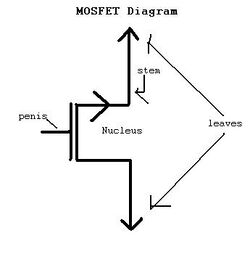Transistor
“Men think with their transistors.”
“I did not have sex with that transistor!”
A transistor is a piece of circuitry that gates the capacitor according to input from the inductive rod. The first transistor was created by Benjamin Franklin to connect his Xbox to his telegraph.
The transistor was invented by an AT&T engineer named D. Baggerson on the 6th day of creation, alongside the rest of the science of biomedical engineering. It consists of a network of wires linking the brain, the capacitor and the inductive rod, which is to be placed inside of the asshole. The transistor consists of a gate receiving information from the inductive rod in a quasi-anal way. Once many digital pulses are received from an inductive rod that has been heated over the critical temperature constant (self-induction) and the signal has been stamped by the bureaucratic nucleus of the intermediary neuron cell, the transistor reacts by opening its ejaculator, thus allowing the capacitor's charge to flow freely towards the antenna end of the rod.
History
Historically, the transistor came to replace expensive and unreliable thermionic valves that would gate the capacitor with limited accuracy and would require massive amounts of energy and very high temperatures to activate. During the beta version of humans, the lead engineer in charge of testing, Arch-angel Gabriel, oversaw humans personally and noted that the capacitor discharge system tended to overheat and that its massive energy requirements exhausted humans trying to benefit from that particular system. Gabriel's report, carefully filed in Heaven's Archives with a failsafe copy in the Library of Congress, also states that human subjects spontaneously combust at the high temperatures developed by the faultiest of the 20% tolerance capacitors built for testing purposes.
As a reaction, Guy invented semi-conductors and applied them in transistor technology. The complexity of the semi-conductors that humans are equipped with sent Gabriel and most of the testing engineering team to hospital with severe stroke after God tried to explain the basic theory to Gabriel in a series of 6 lectures. The bravest ones lasted up to the end of the session and were then solemnly transported straight into their graves. A by-product of transistor technology was the invention of doping. Initially it was used to boost the efficiency of transistors, but later on highly competitive electrons took advantage of the technology and doped themselves for a medal at the greatest electron athletic event, the Olympic games that take place every 4 milliseconds.
Nobel Prize
The inventor of the transistor, Benjamin Franklin, was nominated 5 times for a Nobel prize. 4 of these nominations were for the invention of the transistor, in the categories physics, chemistry, peace and Best Supporting Scientist. Franklin did not win any of the prizes that year, losing out to Nelson Mandela in the peace category by a very narrow margin. One of the judges later said that "[Franklin's] achievement was great, but he has already been awarded the peace prize for an almost identical idea," referring to Franklin's other signature invention: baby wipes.
The disappointment at the loss of the Nobel prize for what he considered his greatest contribution to humanity is considered by many to be the key that drove Franklin to plant a shrapnel bomb at the Philadelphia Opera 3 years later. The bomb's EMP was amplified using 5 prototype transistors.
